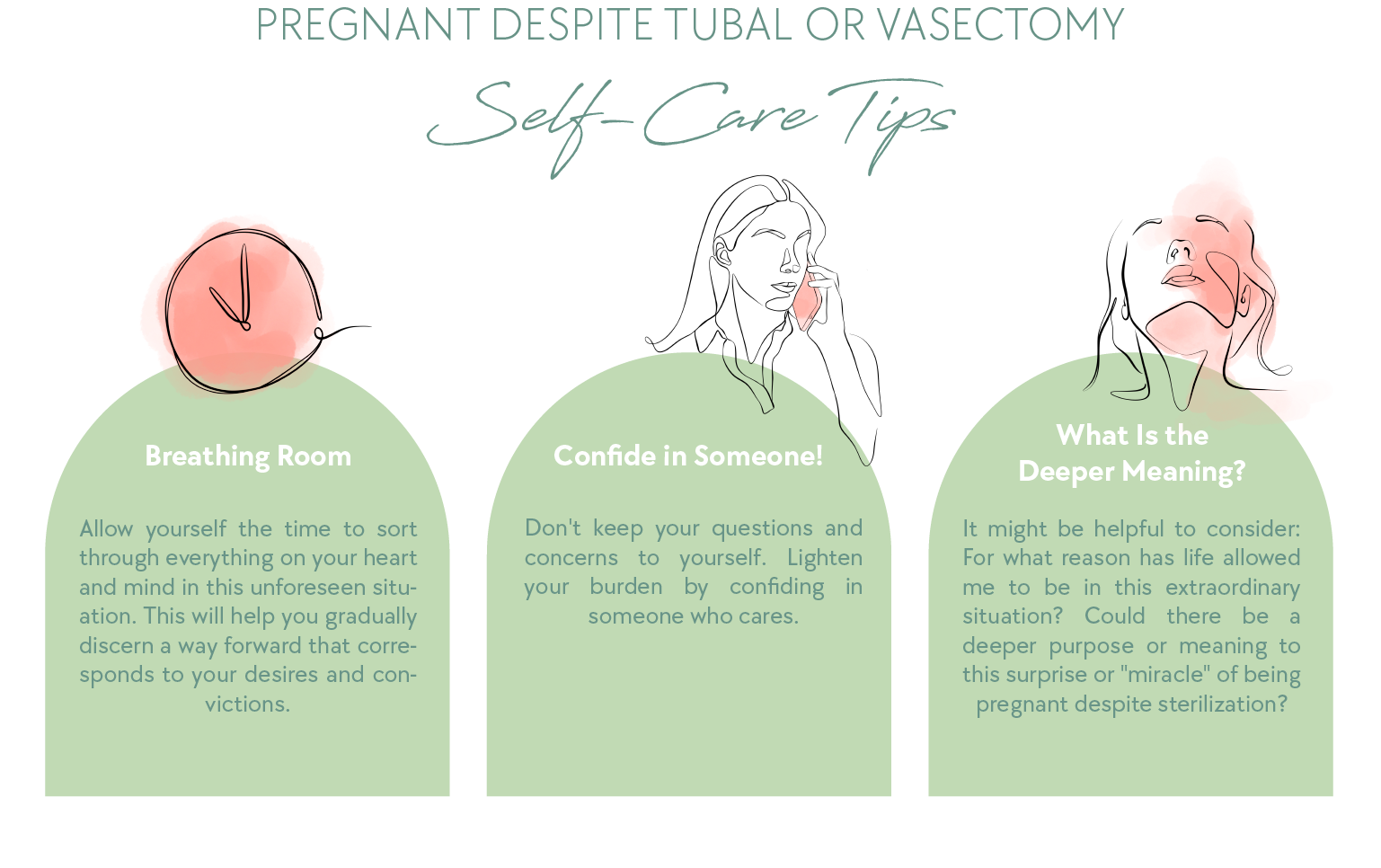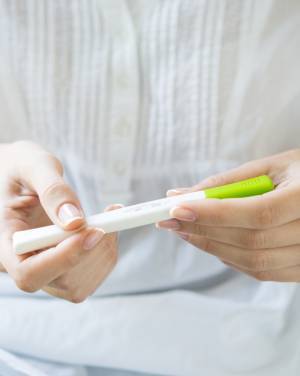Can You Get Pregnant After Sterilization?
- Sterilization (male and female) is generally considered one of the safest contraceptive methods. Nevertheless, pregnancies sometimes happen despite sterilization.
- The probability of this happening is extremely low. Only 1-3 in 1,000 women become pregnant every year after sterilization.
- Reasons for this are surgical mistakes or oversights. In rare cases, recanalization may occur: In women, the uterus and fallopian tubes reunite; in men, the vas deferens grows back.
You may like:
- 🤰🏻 "Am I pregnant?" - Take the free Online Pregnancy Test
Probability and Causes
Pregnancies can still occur after vasectomies or tubal ligations. Here is an overview of the probability and the possible reasons:
|
Vasectomy |
Tubal Ligation |
|
|---|---|---|
|
Chances of Pregnancy |
Pearl Index: 0.1 - 0.15 |
Pearl Index: 0.2 - 0.3 |
|
Reasons / Causes |
|
|
Pregnant After Vasectomy
Even after a vasectomy, which is supposed to result in male infertility, pregnancies can still occur.
Possible Reasons:
- One potential reason may be that complications arose during surgery or there was an oversight.
- Sperm, present in the seminal vesicle or the seminal duct at the time of the procedure, may still be in the semen. This sperm would be capable of fertilization weeks, or even months, after the vasectomy. Therefore, it is common practice to have a semen analysis two months after the procedure to determine whether the sterilization was successful. Meanwhile, backup birth control methods are used. If this is not taken into consideration, pregnancy may occur.
- While rare, the severed vas deferens may regenerate in the first few months after the vasectomy and grow back to create a new connection. This is called recanalization. For this reason, one or two follow-up visits are encouraged. Very rarely, recanalization happens years after the procedure, enabling the man to procreate again. Therefore, in some cases, pregnancies may occur years after successful sterilization by vasectomy.
Pregnant After Tubal Ligation
Possible Reasons:
- Complications are possible also in this procedure.
- Additionally, the kind of surgical sterilization method chosen can make a difference. Severing or cauterizing the fallopian tubes is generally more reliable than clamping them.
- While rare, the uterus and the ovaries may reconnect via new channels. This is called recanalization. It occurs more frequently in younger than in older women.
Am I Pregnant Despite Sterilization?
- 🤔 Could my symptoms be early signs of pregnancy? Take the test!
You may feel very confused at the moment: You or your partner have been sterilized, and the possibility of a pregnancy was therefore entirely out of the question... But now you are noticing pregnancy symptoms.
Start by taking a deep breath. Your overdue period doesn’t necessarily mean that you are pregnant. A woman's monthly cycle, which usually continues after tubal litigation, is very sensitive. Many external factors, such as stress, diet, long-distance travel, infections, or medications, can cause a delay.
Consult Your Doctor
You may also be experiencing a non-viable pregnancy. If fertilization of an egg occurs despite tubal, the risk of an ectopic pregnancy is increased. It is also possible that you have an abdominal pregnancy. We recommend that you have this checked by your healthcare provider as soon as possible.
Unintended Pregnancy After Tubal or Vasectomy — Now What?
If you are pregnant despite sterilization, this news may have pulled the rug from under your feet... After all, sterilization gives you a sense of finality, which makes this pregnancy completely unexpected. Your pregnancy may have also gone unnoticed for a while, especially since, unlike condoms, sterilizations don’t come with classic "contraceptive failures.”


While thinking through your next steps, take one of our free quizzes. Our team of compassionate experts has created these resources to help you sort through your thoughts and gain clarity:
- ⚖️ Taking our free Abortion Test may also help as you wade through the “whys” and “what ifs.”
- 🧑🏽⚕️ (Suspecting a) pregnancy — How soon to see a doctor? — Test
Sterilization Facts
Sterilization is the world’s leading method of birth control. On average, 18.9% of the world’s population relies on female sterilization, whereas 8.4% of sexually active adults name vasectomies as their method of birth control. Europe has much lower numbers than the rest of the world, at 3.8% for tubal ligations and 2.7% for vasectomies. (Source: O’Neill Institute, 2018)
The prevalence of tubal ligations increases with age:
In the US, 4.2% of women aged 20-29 — 21.6% of women aged 30-39 — 39.4% of women aged 40-49 undergo tubal ligations for birth control. (Source: CDC, 2019)
Vasectomies
- Male sterilizations (vasectomies) involve the severing and possible shortening of the two sperm ducts (vas deferens) in the scrotum. This prevents sperm from entering the semen (ejaculate). The ends of the vas deferens are sealed by cauterization, tying, chemical substances, and/or titanium clips.
- A vasectomy procedure is less complicated and faster than a tubal ligation, which involves significantly more surgical risks.
- Hormones and sperm are still produced, by which erectile function is maintained. However, the sperm is absorbed within a man’s system. Therefore, when ejaculation occurs, the semen no longer contains sperm cells, but only the fluid of the seminal and prostate glands.
- Risk Factors: Vasectomies can be hard on men emotionally. One to two percent of men experiences physical complications, such as testicular infections, bruising, or inflammation. Chronic pain (post-vasectomy pain syndrome) is also a possible side effect.
Tubal Ligations
- Sterilization of women by tubal ligation is a surgical procedure involving clamping, severing, or cauterizing of both fallopian tubes. This prevents egg cells from entering the uterus and fusing with a male sperm cell. The procedure is performed by laparoscopy or laparotomy.
- Compared to vasectomies, some surgical risks are higher.
- After sterilization, the ovaries continue to produce hormones and ova (egg cells). Therefore, ovulation still occurs, but the egg cells are now transported via the mucous membranes of the fallopian tubes into the abdominal cavity, where they are absorbed. The procedure can lead to a decreased blood supply to the ovaries, which in rare cases can impair their function, including their hormone production.
- Risk Factors: Side effects include mood swings, insomnia, low libido, and hot flashes. Other physical risks and complications of tubal ligations include bleeding, infections, and damage to internal organs. Depression or anxiety are frequently noted as side effects of the procedure.
FAQs
-
The likelihood of becoming pregnant after sterilization is very low.
2-3 in 1,000 women become pregnant per year despite tubal ligations. (Pearl Index: 0.2 - 0.3).
1-2 in 1,000 women become pregnant per year despite their partner’s vasectomy. (Pearl Index: 0.1- 0.15). -
There are several reasons for a pregnancy, e.g., complications during the operation or an unnoticed mistake.
Fertilizable sperm may also still be present in the vesicular gland or the vas deferens for some time after a vasectomy. In women, the tubal ligation method may play a role in the effectiveness.
Recanalization could also allow for conception to occur. This involves the uterus and ovary reuniting in women and the vas deferens growing back in men. -
Male sterilization (vasectomy) involves cutting the two vas deferens in the scrotum. Female sterilization (tubal ligation or “getting your tubes tied") blocks the two fallopian tubes. Tubal ligations are associated with more surgical risks than vasectomies. Still, other risks, such as infection or emotional repercussions, are possible for both genders. The Pearl Index is slightly higher for tubal ligations than vasectomies: After female sterilization, 2-3 in 1,000 women will still become pregnant annually, compared to 1-2 women after their partner’s vasectomy. In addition to possible surgical errors, the vas deferens may reconnect. It is also possible for the fallopian tubes to reconnect to the uterus. Additionally, the method of sterilization can affect the outcome. After a vasectomy, fertilizable sperm may still be present for some time, making pregnancy possible despite sterilization.















